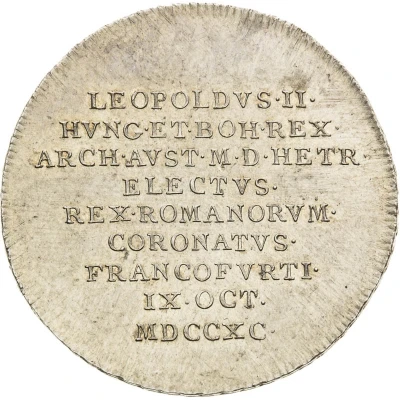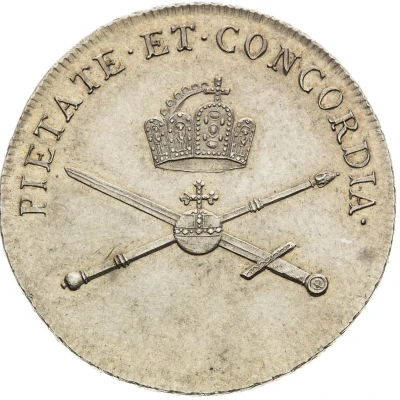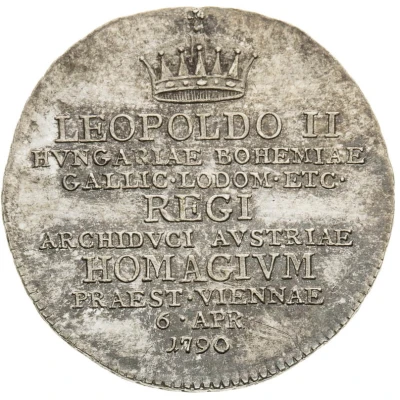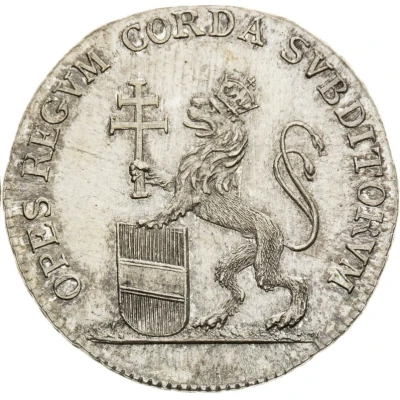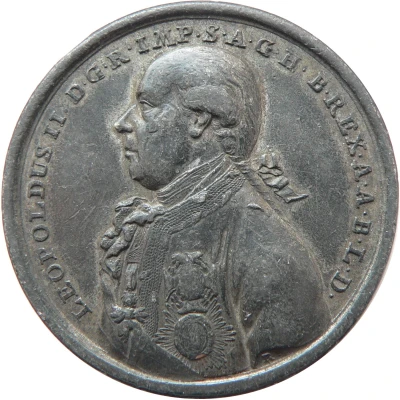
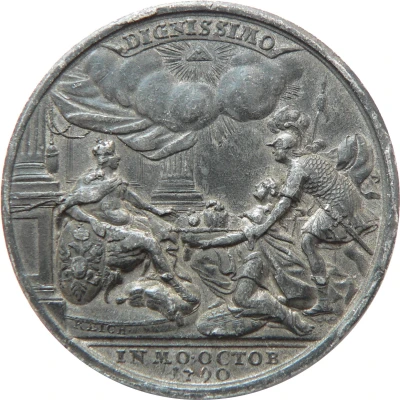

© ZacUK
Medal - Crowning of Leopold II
1790 year| Tin | 36.63 g | 47 mm |
| Location | Austrian Empire |
|---|---|
| Emperor | Leopold II (1790-1792) |
| Type | Personality medals › Coronation and election medals |
| Year | 1790 |
| Composition | Tin |
| Weight | 36.63 g |
| Diameter | 47 mm |
| Thickness | 3 mm |
| Shape | Round |
| Technique | Milled |
| Orientation | Medal alignment ↑↑ |
| Demonetized | Yes |
| Updated | 2024-11-14 |
| Numista | N#143760 |
|---|---|
| Rarity index | 95% |
Reverse
A kneeling Germania, protected by a knight (Ares) behind him, hands Leopold II (enthroned at left) the crown of Charlemagne and orb. God's all-seeing eye in clouds above. Lettering above and in double exergue. Engraver's name below throne.
Script: Latin
Lettering:
DIGNISSIMO
REICH
IN MO · OCTOB. 1790
Engraver: Johann Christian Reich
Edge
Plain
Comment
Description: Medal "On Coronation as King of Hungary" by Reich, commemorating coronation in Frankfurt of Leopold II of Austria as 'Holy Roman Emperor'.Reference: Foerschner 397.2
Metal: Tin/Pewter
Engraver: Reich, Johann Christian (Eisenberg, en 1730 - Fürth, en 1814)
Some versions also have a copper plug in lower part.
Obverse: Bust of Leopold II on the left, the Golden Fleece on the neck, the cordon of the order of Maria Theresa on the coat, the plates of the order of Maria Theresa and the Order of St. Stephen of Hungary on the chest.
Reverse: Leopold II, seated on the right, leaning on a shield with the coat of arms of the Empire, receives the imperial insignia presented by a kneeling figure held by a warrior dressed in antique fashion; above the scene a radiant triangle arises from the clouds.
Leopold II (1747-1792)
His coronation as 'Holy Roman Emperor' took place in Frankfurt on the 9th of October 1790. From the year 855 the German kings and emperors had been elected in Frankfurt and crowned in Aachen. From 1562 the kings/emperors were also crowned in Frankfurt, Maximilian II being the first one. This tradition ended in 1792, when Franz II (Leopold's son) was elected.
However, Leopold lived for barely two years after his accession as Holy Roman Emperor, and during that period he was hard pressed by peril from west and east alike. The growing revolutionary disorders in France endangered the life of his sister Marie Antoinette of Austria, the queen of Louis XVI, and also threatened his own dominions with the spread of a subversive agitation. His sister sent him passionate appeals for help, and he was pestered by the royalist emigrants, who were intriguing to bring about armed intervention in France.
From the east he was threatened by the aggressive ambition of Catherine II of Russia and by the unscrupulous policy of Prussia. Catherine would have been delighted to see Austria and Prussia embark on a crusade in the cause of kings against the French Revolution. While they were busy beyond the Rhine, she would have annexed what remained of Poland and made conquests against the Ottoman Empire. Leopold II had no difficulty in seeing through the rather transparent cunning of the Russian empress, and he refused to be misled.
Pierre-Leopold of Habsburg-Lorraine, nor to the castle of Schönbrunn (near Vienna) on May 5, 1747, and died in Vienna on March 1, 1792, Grand Duke Leopold I of Tuscany (1765-1790) then emperor of the Romans under name of Leopold II, Apostolic King of Hungary, King of Bohemia, Archduke Sovereign of Austria (1790-1792), was the third son of Francis I, ruler of the Romans, Grand Duke Francis II of Tuscany, former Duke Francis III of Lorraine and Bar, and his wife Marie Therese Ire, Queen of Hungary and Bohemia, sovereign archduchess of Austria.
Leopold was first destined for the ecclesiastical state, and it is thought that it was precisely the theological studies to which he was constrained here influenced him adversely towards the Church. When his elder brother Charles died in 1761, it was decided that he would succeed his father as Grand Duke of Tuscany, grand duchy who was erected as a "secundogeniture", that is to say, as a prerogative for the second son. This disposition was the condition of his marriage, August 5, 1765, with Marie Louise, daughter of Charles III of Spain and Marie-Amelie of Saxony. His father Francis I died in Innsbruck during the festivities here, and on 18 August 1765 he succeeded as Grand Duke of Tuscany.
